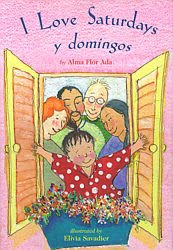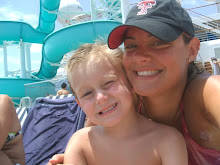Clementine is worried when she has no talent for the talent show. She is distressed that everyone around her seems to have great talents while she cannot think of a single one. However, Clementine being the spunky character that she is, shines through anyway. This book gives readers a chance to think about their own unique talents and what makes them special. If I used this book in the classroom, we would do a lot of activities about noticing all of the great characteristics that we all have!Clementine helps readers realte to her and I think that many students would really enjoy this reading and the other Clementine collections.
Wednesday, August 6, 2008
The Talented Clementine by Sara Pennypacker
Clementine is worried when she has no talent for the talent show. She is distressed that everyone around her seems to have great talents while she cannot think of a single one. However, Clementine being the spunky character that she is, shines through anyway. This book gives readers a chance to think about their own unique talents and what makes them special. If I used this book in the classroom, we would do a lot of activities about noticing all of the great characteristics that we all have!Clementine helps readers realte to her and I think that many students would really enjoy this reading and the other Clementine collections.
Posted by Madeline at Wednesday, August 06, 2008 0 comments
Craft Lesson 3: Using patterns and repetition in our stories
Discussion:
When writing stories in the classroom, it is important to teach students about having patterns and rhythm in our writing so that readers can follow easily. This will be a concept that is very important in primary grades because writing can be sporadic when new ideas come into the child’s mind. I encourage them to write as they think, but this can cause problems when the story has no pattern. It is important for the reader to be able to understand the story, as well as be able to try to predict what they believe might happen later in the story. This will give the story credibility and validation. In first or second grade, this might be a tricky concept to understand so we will talk a lot about it and I will give them plenty of examples.
How to Teach It:
I will start the lesson by asking the students what they think is important when they are reading a story, the students can be sitting on the floor so that we are all close together and in a sharing environment. If no one brings up the idea about patterns and rhythm, I will hint at it by explaining that it is imperative for the story to not “jump around” and loose the reader’s attention. I will read a short story that I have created that has no rhythm or easy to follow story lines. I will create a lot of main topics and a lot of sub topics and when I have completed reading the story, I will ask them to tell me what the main idea of the story was. When the students all respond with many different answers, this will show them that my story lacked a pattern and a rhythm that was easy to follow. I will also stop in the middle of my story and ask the students to predict what is going to happen next. I will discuss this aspect upon completing my story as well. We will talk a lot about why rhythm and flow are important in stories and why they are so meaningful. After our discussion, we will read, The Napping House. As we get further in the story, I will become silent on the repetitive sentences and have the children say that part aloud together. After the story, I want the students to write their own story with an obvious pattern so that I can ensure that they have acquired this aspect of writing correctly.
Posted by Madeline at Wednesday, August 06, 2008 0 comments
Craft Lesson 2 : Celebrating important people in our lives.
Discussion:
I think that it is important for students to understand important people in our society. This book by Patrick J. Lewis is a collection of poems about people that have changed our culture. He wrote about Rosa Parks, Martin Luther King and the firefighters on 9/11. The poems are easy for students to read and understand, while still gaining a perspective on how important these people are. This craft lesson is not intended to correct something that my students are lacking, the purpose is to give my students a chance to think about someone in their lives that they think that have made a difference. This person may be someone who has changed history, or save millions of lives, but someone who has made a difference to them. I want this craft lesson to give my students a time to write freely about someone who has made a difference to them.
How to Teach It:
First, I will ask the students about anyone in their lives that they feel has made a difference to them or someone else important to them. This person could be their foster parents, their adopted families, a case worker, or their family. This discussion will lead us into our story. I will share with them a few poems about people that they are familiar with and also, people that they might not know about. For some of the poems, I will read them and have them try to guess who the person is. After sharing poems, I will have the students come up with their own poems or a sample of writing about people or individuals who have made a difference to them. After they have free time to write, I will prompt them to draw a picture that relates to their writing. This could be a portrait, a comic strip, a book, any illustration that they would like that they feel best describes their writing. After I give the students time for all of these activities, we will come together as a group and share who our hero is. I will also be writing and drawing while the students are, to encourage them to keep going with their ideas. I will start our gathering by showing the students who is my hero is and then allow them to share with the class as well.
I would like to demonstrate this craft lesson on September 11th, or before Martin Luther King Day, or Presidents Day to show my students how these will always be days that will be recognized because people stood up and fought for something that was important to them. I want my students to recognize heroes in their lives and know that they can be heroes too.
Posted by Madeline at Wednesday, August 06, 2008 0 comments
Tuesday, August 5, 2008
Craft Lesson 1
I feel that it is very important for children to be themselves and to depend on their own hard work and to give them enough assurance that they feel really good about their work. I want the students in my classroom to be proud of their work and have the self confidence to share their work with myself and other students. I want to ensure that my students are always proud of their work and proud of whom they are, and I want to do a craft lesson in order to show my students that they can rely on themselves and be independent in their work. I will help them understand this concept by reading Tops and Bottoms and leading the class in a discussion. I think that in elementary school, especially around the 3rd, 4th and 5th grade, students start to doubt themselves and their work and they start comparing their work to other students. I really want to make sure that my students feel comfortable in their writing and confident in their reading. In this book, I think that there is a really strong message that we should depend on ourselves and work hard to achieve the goals that we desire. We need to be hard working, confident and independent when it is something that is really important to us.
I want to introduce this book to my students before our writing workshops. I want them to have the idea in their heads that it is important to write about what is in their heads. I want them to be independent writers and write about what is on their minds.
Before reading the book, I want to talk with my class about being independent. I will ask them, “What makes you different from your friends or other students in classroom?” I will have them write their response on a paper and then I will have them write about what they think that their best qualities or writing are. Then we will talk about why it is important to use our own thoughts and our own ideas in our writing. I will then have them write about whatever they want to write about using their own ideas before we write about other topics.
Posted by Madeline at Tuesday, August 05, 2008 3 comments
Tuesday, July 29, 2008
Upside Down and Backwards
 Upside Down and Backwards is by Diane Gonzales Bertrand. This book is a combination of English and Spanish stories. Half of the book is in English while the other half is in Spanish. Similar to the title, when a reader wants to switch from one language to the other, the reader has to flip the book upside down and backwards! I think it is so neat that both languages are in the entire book. This will allow students who are not fluent in one of the languages to still feel that they are on the same path as the other students in the classroom. There are many stories that make up the entirety of this book. All of them are short and well written with humor and creativity.
Upside Down and Backwards is by Diane Gonzales Bertrand. This book is a combination of English and Spanish stories. Half of the book is in English while the other half is in Spanish. Similar to the title, when a reader wants to switch from one language to the other, the reader has to flip the book upside down and backwards! I think it is so neat that both languages are in the entire book. This will allow students who are not fluent in one of the languages to still feel that they are on the same path as the other students in the classroom. There are many stories that make up the entirety of this book. All of them are short and well written with humor and creativity.
Posted by Madeline at Tuesday, July 29, 2008 3 comments
Thursday, July 24, 2008
Thursday, July 17, 2008
The Name Jar
Posted by Madeline at Thursday, July 17, 2008 0 comments
When I heard the learn'd astronomer
Posted by Madeline at Thursday, July 17, 2008 0 comments
Tuesday, July 15, 2008
Los Gatos Black on Halloween
Posted by Madeline at Tuesday, July 15, 2008 2 comments
I Love Saturdays y Domingos
I Love Saturdays y Domingos is a wonderful, culturally accurate story about a girl who spends the weekends with her grandparents. She spends Saturdays with her grandma and grandpa and they make her pancakes and she plays with her grandmother's cat. On Sundays, she spends the days with her abuelito and abuelita. They make her huevos rancheros, and she plays on her abuelita's farm with the chickens. I feel that this book shows a close comparison to the two different cultures. Every other page is english or spanish and it is helpful for young readers to see how english and spanish are closely related. I really like the part when the girl's grandpa would talk about how his family came from Europe and her abuelito talked about Mexico. The birthday story also stood out to me because it is important to see how the two different cultures celebrate birthdays. I would have this book in my classroom and I think it would be one of the favorites. 
Posted by Madeline at Tuesday, July 15, 2008 1 comments











